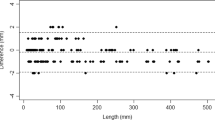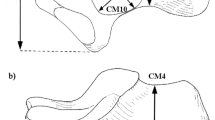Abstract
Best scientific practice for sex estimation incorporates accurate techniques that employ appropriate standards and population- and period-specific data. Single measurements provide accurate sex estimations, but multiple measurements and multivariate techniques offer greater validity to biological profile assessments. Appropriate, modern standards for sex estimation are limited to the cranium in South Africans (SA), which warrants the examination of the potential for sex estimation using the postcrania of socially defined SA blacks, whites and coloureds through multivariate models and advanced statistical techniques. A total of 39 standard osteometric measurements were taken from the postcrania of 360 socially defined SA blacks, whites and coloureds (equal sex and ancestry). Univariate and multivariate models were evaluated. Multivariate models, with cross-validation and equal priors, were explored with linear and flexible discriminant analysis (LDA and FDA, respectively). Classification accuracies associated with univariate models ranged from 56 to 89%, whereas multivariate classification accuracies using bone models (i.e. all measurements from one element) ranged from 75 to 91%. The highest correct classifications were achieved with multivariate subsets (i.e. combinations of measurements from different bones) and ranged from 90 to 98%. Overall, FDA and LDA yielded similar accuracy rates. Postcranial bones achieve comparable classification accuracies to the pelvis and higher accuracies than metric or morphological techniques using the cranium. While LDA is the most commonly used classification statistic in biological anthropology, FDA provides a good alternative for classification.



Similar content being viewed by others
References
Scientific Working Group for Forensic Anthropology (2010) Sex Assessment. In: Sci. Work. Group Forensic Anthropol. SWGANTH. http://swganth.startlogic.com/. Accessed 27 Jun 2015
Spradley MK, Anderson BE, Tise ML (2015) Postcranial sex estimation criteria for Mexican Hispanics. J Forensic Sci 60:S27–S31
Spradley MK, Jantz RL (2011) Sex estimation in forensic anthropology: skull versus postcranial elements. J Forensic Sci 56:289–296
Steyn M, İşcan MY (1999) Osteometric variation in the humerus: sexual dimorphism in South Africans. Forensic Sci Int 106:77–85
Asala SA (2001) Sex determination from the head of the femur of South African whites and blacks. Forensic Sci Int 117:15–22
Bidmos M, Asala SA (2003) Discriminant Function sexing of the calcaneus of the South African Whites. J Forensic Sci 48:1–6
Stull KE, Kenyhercz MW, L’Abbé EN (2014) Ancestry estimation in South Africa using craniometrics and geometric morphometrics. Forensic Sci Int 245:206.e1–206.e7
Statistics South Africa (2011) Census. South Africa. pp 1–88. Available from: www.beta2statssa.gov.za. Accessed 16 August 2014
Statistics South Africa (2014) Mid-year population estimates. pp 1–19. Available from: www.beta2statssa.gov.za. Accessed 29 March 2015
Klales AR, Ousley SD, Vollner JM (2012) A revised method of sexing the human innominate using Phenice’s nonmetric traits and statistical methods. Am J Phys Anthropol 149:104–114
Grivas CR, Komar DA (2008) Kumho, Daubert, and the nature of scientific inquiry: implications for forensic anthropology. J Forensic Sci 53:771–776
Krüger GC, L’Abbé EN, Stull KE, Kenyhercz MW (2015) Sexual dimorphism in cranial morphology among modern South Africans. Int J Legal Med 129:869–875
Liebenberg L, Stull KE, L’Abbé EN, Botha D (2015) Evaluating the accuracy of cranial indices in ancestry estimation among South African groups. J Forensic Sci 60:1277–1282
Liebenberg L, L’Abbé EN, Stull KE (2015) Population differences in the postcrania of modern South Africans and the implications for ancestry estimation. Forensic Sci Int 257:522–529
Kenyhercz MW (2012) Sex estimation using pubic bone morphology in a modern South African sample: a test of the Klales et. al. method. In: Am. J. Phys. Anthropol. Wiley-Blackwell, pp 179–180
L’Abbé EN, Nawrocki SP, Keough N (2013) L’Abbé, Nawrocki, Keough - 2008 - The application of FORDISC 3 . 0 to South African crania.pdf
Ramsthaler F, Kreutz K, Verhoff MA (2007) Accuracy of metric sex analysis of skeletal remains using Fordisc® based on a recent skull collection. Int J Legal Med 121:477–482
L’Abbé EN, Loots M, Meiring JH (2005) The Pretoria bone collection: a modern South African skeletal sample. HOMO - J Comp Hum Biol 56:197–205
L’Abbé EN, Steyn M (2012) The establishment and advancement of forensic anthropology in South Africa. In: Dirkmaat DC (ed) Companion Forensic Anthropol. Wiley-Blackwell, UK, pp 626–638
Adhikari M (2005) Contending approaches to coloured identity and the history of the coloured people of South Africa. Hist Compass 3:1–16
Patterson N, Petersen DC, van der Ross RE et al (2010) Genetic structure of a unique admixed population: implications for medical research. Hum Mol Genet 19:411–419
Stull KE, L’Abbé EN, Ousley SD (2014) Using multivariate adaptive regression splines to estimate subadult age from diaphyseal dimensions: subadult age estimation from diaphyses. Am J Phys Anthropol 154:376–386
Quintana-Murci L, Harmant C, Quach H et al (2010) Strong maternal Khoisan contribution to the South African coloured population: a case of gender-biased admixture. Am J Hum Genet 86:611–620
Steyn M, İşcan MY (1998) Sexual dimorphism in the crania and mandibles of South African whites. Forensic Sci Int 98:9–16
L’Abbé EN, Van Rooyen C, Nawrocki SP, Becker PJ (2011) An evaluation of non-metric cranial traits used to estimate ancestry in a South African sample. Forensic Sci Int 209:195.e1–195.e7
Greeff JM (2007) Deconstructing Jaco: genetic heritage of an Afrikaner. Ann Hum Genet 71:674–688
Beck RB (2000) The history of South Africa. Greenwood Press, Westport
Tishkoff SA, Reed FA, Friedlaender FR et al (2009) The genetic structure and history of Africans and African Americans. Science 324:1035–1044
Tishkoff SA, Williams SM (2002) Genetic analysis of African populations: human evolution and complex disease. Nat Rev Genet 3:611–621
May A, Hazelhurst S, Li Y et al (2013) Genetic diversity in black South Africans from Soweto. BMC Genomics 14:644
Herbert RK (1990) The sociohistory of clicks in Southern Bantu. Anthropol Linguist 32:295–315
Stynder DD (2009) Craniometric evidence for South African Later Stone Age herders and hunter–gatherers being a single biological population. J Archaeol Sci 36:798–806
Moore-Jansen PH, Jantz RL (1994) Data collection procedures for forensic skeletal material, 3rd ed. Forensic Anthropology Center, Department of Anthropology, University of Tennessee, Knoxville
Jantz RL, Ousley SD (2005) Fordisc 3: computerized forensic discriminant functions. University of Tennessee, Knoxville
R Core Team (2013) R: a language and environment for statistical computing. In: R Found. Stat. Comput. Vienna Austria. http://www.R-project.org/
Ulijaszek SJ, Kerr DA (1999) Anthropometric measurement error and the assessment of nutritional status. Br J Nutr 82:165–177
Perini TA, de Oliveira GL, dos Santos OJ, de Oliveira FP (2005) Technical error of measurement in anthropometry. Rev Bras Med Esporte 11:81–85
Fernandez R, Fernandez G (2009) Validating the Bland-Altman method of agreement. In: Annu. Conf. West. Users. SAS Softw, San Jose Calif, pp 1–17
Sedgwick P (2013) Limits of agreement (Bland-Altman method). BMJ 346:f1630–f1630
Ousley SD, Jantz RL (2012) Fordisc 3 and statistical methods for estimating sex and ancestry. In: Dirkmaat DC (ed) Companion Forensic Anthropol. Wiley-Blackwell, West Sussex, pp 311–329
Dawson-Saunders B, Trapp RG (2004) Basic and clinical biostatistics, 4th edn. McGraw-Hill, New York
Ripley B (2015) MASS: Support functions and datasets for Venables and Ripley’s MASS. http://cran.r-project.org/web/packages/MASS/MASS.pdf. Accessed 29 Jun 2015
Hastie T, Tibshirani R, Buja A (1994) Flexible discriminant analysis by optimal scoring. J Am Stat Assoc 89:1255–1270
Milborrow S (2013) Notes on the earth package. http://CRAN.R-project.org/package=earth
Leathwick JR, Rowe D, Richardson J et al (2005) Using multivariate adaptive regression splines to predict the distributions of New Zealand’s freshwater diadromous fish. Freshw Biol 50:2034–2052
Hastie T (2013) mda: mixture and flexible discriminant analysis. http://cran.r-project.org/web/packages/mda/index.html
Elewa AMT (2010) Morphometrics for nonmorphometricians. Springer Berlin Heidelberg, Berlin Heidelberg
Steyn M, İşcan MY (1997) Sex determination from the femur and tibia in South African whites. Forensic Sci Int 90:111–119
France DL (1998) Observational and metric analysis of sex in the skeleton. In: Reichs KJ (ed) Forensic Osteol. Adv. Identif. Hum. Remains, vol 2nd. Charles C. Thomas, Springfield, pp 163–186
Scheuer L, Black S (2004) The juvenile skeleton. Elsevier Academic Press, New York
Stull KE (2014) An osteometric evaluation of age and sex differences in the long bones of South African children from the Western Cape. PhD Dissertation, University of Pretoria
Bogin B (1999) Patterns of human growth. In: Camb. Stud. Biol. Anthropol, vol 2nd. Cambridge University Press, Cambridge, p 267
Walker PL (2008) Sexing skulls using discriminant function analysis of visually assessed traits. Am J Phys Anthropol 136:39–50
Panik MJ (2005) Advanced statistics from an elementary point of view. Academic Press
Vance VL, Steyn M, L’Abbé EN (2011) Nonmetric sex determination from the distal and posterior humerus in black and white South Africans. J Forensic Sci 56:710–714
L’Abbé EN, Kenyhercz MW, Stull KE et al (2013) Application of FORDISC 3.0 to explore differences among Crania of North American and South African blacks and whites. J Forensic Sci 58:1579–1583
Phenice TW (1969) A newly developed visual method of sexing the os pubis. Am J Phys Anthropol 30:297–301
Acknowledgments
This research was funded by the National Research Foundation (NRF). Any opinions, findings and conclusions or recommendations expressed in the material are those of the authors and therefore the NRF does not accept any liability in regard thereto. The authors would like to thank A. Alblas and L. Greyling (Division of Anatomy and Histology, University of Stellenbosch) for assistance with the Kirsten Collection.
Author information
Authors and Affiliations
Corresponding author
Ethics declarations
Ethical standards
Ethical clearance for this study was obtained from the Student Ethics Committee (s296/2013), Faculty of Health Sciences, University of Pretoria. The skeletal material was handled under the Human Tissue Act 61 of 2003 and in accordance with the Declaration of Helsinki of 1975, as revised in 2000 and 2008.
Rights and permissions
About this article
Cite this article
Krüger, G.C., L’Abbé, E.N. & Stull, K.E. Sex estimation from the long bones of modern South Africans. Int J Legal Med 131, 275–285 (2017). https://doi.org/10.1007/s00414-016-1488-z
Received:
Accepted:
Published:
Issue Date:
DOI: https://doi.org/10.1007/s00414-016-1488-z




